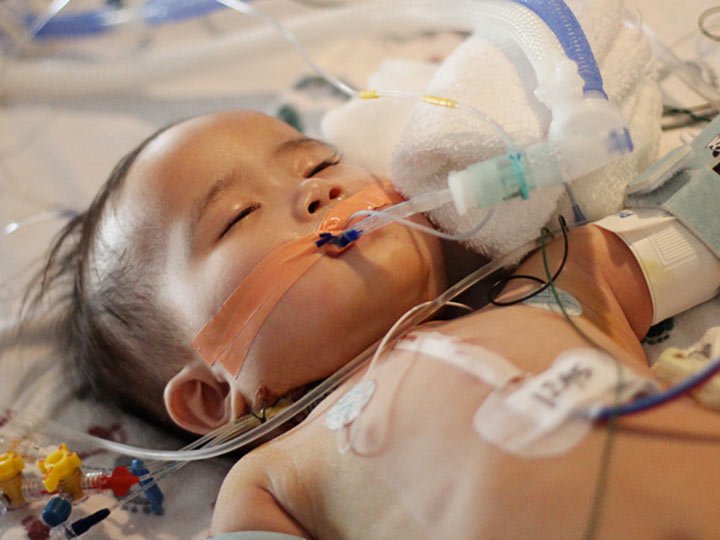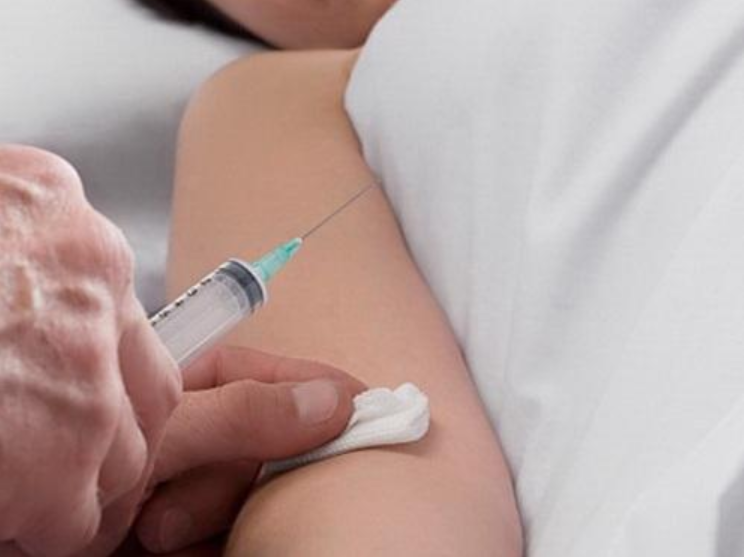Emergency treatment for children with seizures
The article was professionally consulted with Master, Doctor Truong Thanh Tam - Pediatrician at the Department of Pediatrics - Neonatology - Vinmec Danang International General Hospital.
Seizures are a common neurological emergency in children. There are many causes of convulsions in children, and if not handled and treated properly, convulsions can be dangerous to children's health.
1. Seizures in children
Seizures are a very common neurological emergency in children. This is a very harmful phenomenon to the body and brain of the child, because convulsions can cause brain hypoxia, especially when the convulsions are prolonged and recur many times. During a seizure, the child may vomit, if not handled properly, the child may breathe in the vomit causing pneumonia or vomit from the stomach back into the lungs causing lung damage; Viscous sputum secreted when a child has a convulsion can cause airway obstruction leading to death.
There are many possible causes of convulsions in children such as:
There are many possible causes of convulsions in children such as:
1.1. Causes of acute convulsions
Children with fever convulsions can be caused by meningitis, encephalitis, brain abscess, febrile convulsion; dysentery, shigella; hand foot mouth virus infection ; cerebral malaria parasite infection. In addition, children can also have febrile convulsions with fever after vaccination, especially after receiving the DPT vaccine (prevents three diseases: diphtheria - pertussis - tetanus).
Children with seizures without fever can be caused by:
Perinatal conditions such as brain malformations, fetal infection, trauma, brain hemorrhage, metabolic error at birth,... Diseases with lesions Nervous system entities such as: head trauma causing concussion, concussion, intracranial hemorrhage; brain-meningeal hemorrhage due to blood clotting disorders, vitamin K deficiency; due to brain tumor, intracranial hematoma; Cerebrovascular occlusion due to congenital heart disease,... Metabolic disorders: convulsions in children may be caused by hypoglycemia, hyperglycemia, vitamin B6 deficiency,... Electrolyte disturbances: convulsions may occur in children. due to hypernatremia and hyponatremia, hypomagnesemia, hypocalcemia,... Children convulsions due to lead and organophosphate poisoning; Poisoning with drugs Amphetamine, anticholinergic, antihistamine, ... Children may have convulsions due to systemic diseases such as lupus erythematosus, kidney failure, encephalopathy, hypertension, central or systemic vasculitis,. ..
Children with seizures without fever can be caused by:
Perinatal conditions such as brain malformations, fetal infection, trauma, brain hemorrhage, metabolic error at birth,... Diseases with lesions Nervous system entities such as: head trauma causing concussion, concussion, intracranial hemorrhage; brain-meningeal hemorrhage due to blood clotting disorders, vitamin K deficiency; due to brain tumor, intracranial hematoma; Cerebrovascular occlusion due to congenital heart disease,... Metabolic disorders: convulsions in children may be caused by hypoglycemia, hyperglycemia, vitamin B6 deficiency,... Electrolyte disturbances: convulsions may occur in children. due to hypernatremia and hyponatremia, hypomagnesemia, hypocalcemia,... Children convulsions due to lead and organophosphate poisoning; Poisoning with drugs Amphetamine, anticholinergic, antihistamine, ... Children may have convulsions due to systemic diseases such as lupus erythematosus, kidney failure, encephalopathy, hypertension, central or systemic vasculitis,. ..

Sau khi tiêm ngừa, trẻ có thể bị sốt kèm co giật
1.2. Causes of chronic convulsions
Epilepsy is the cause of acute convulsions. Seizures are short episodes, lasting from a few seconds to a few minutes, with the same defining characteristics as the previous ones, occurring suddenly, showing dysfunction of the central nervous system.
2. Emergency treatment for children with seizures
The principles of treatment for children with convulsions are to clear the airway and provide oxygen to support the child's breathing, treatment to stop the seizure, and treat the cause of the seizure. Accordingly, the treatment methods are as follows:
2.1. Respiratory support for convulsive children
Put the child to lie on his side, with his head back to let the mucus secrete out, put a compress on the tongue to wrap the gauze if the child is twitching, suck the mucus, give the child oxygen to get SaO2 from 92-96%. If oxygen therapy fails or there is apnea, proceed to intubate the child.

Đặt nội khí quản là phương pháp hỗ trợ hô hấp cho trẻ co giật
2.2. Treatment to stop seizures
Intravenous injection for children with diazepam 0.2mg/kg/dose, prepare a balloon and a breathing mask in case of apnea when using the drug. In cases where intravenous injection is not possible, the drug can be injected through the anus at a dose of 0.5mg/kg/dose.
If the first dose is not effective, repeat the second dose after 10 minutes. Use up to 3 doses. If a total dose of 1mg/kg Diazepam does not stop the seizure, transfer the child to resuscitation.
If Diazepam is not used, a child with seizures can be treated with Midazolam at a dose of 0.2mg/kg/time by slow intravenous injection. If the child does not respond, the above dose can be repeated. The maintenance dose of Midazolam infusion is 1 μg/kg/min, gradually increasing the dose until a response is obtained, the dose should not exceed 18 μg/kg/min. For neonates, it is preferable to choose Phenobarbital at a dose of 15-20mg/kg intravenously over 30 minutes. If after 30 minutes the child still has convulsions, a second dose of 10 mg/kg can be repeated.
If the first dose is not effective, repeat the second dose after 10 minutes. Use up to 3 doses. If a total dose of 1mg/kg Diazepam does not stop the seizure, transfer the child to resuscitation.
If Diazepam is not used, a child with seizures can be treated with Midazolam at a dose of 0.2mg/kg/time by slow intravenous injection. If the child does not respond, the above dose can be repeated. The maintenance dose of Midazolam infusion is 1 μg/kg/min, gradually increasing the dose until a response is obtained, the dose should not exceed 18 μg/kg/min. For neonates, it is preferable to choose Phenobarbital at a dose of 15-20mg/kg intravenously over 30 minutes. If after 30 minutes the child still has convulsions, a second dose of 10 mg/kg can be repeated.

Tiêm tĩnh mạch giúp cắt cơn co giật
2.3. Treat the cause
If the child has a convulsion due to high fever, give him or her to use Paracetamol 15-20mg/kg/time, the drug should be used in the form of a suppository, administered by the anus. Children convulsing due to hypoglycaemia, for older children 30% Dextrose intravenous infusion 2ml/kg, for infants 10% Dextrose intravenous infusion 2ml/kg, then maintain with 10% Dextrose. Children with seizures due to hyponatremia: use 3% sodium chloride dose of 6-10ml/kg intravenously for 1 hour. Treatment of increased intracranial pressure (if any) and treatment of surgical causes such as cerebral hemorrhage, head trauma, brain tumor,...
2.4. Next treatment
If the above methods have been performed and the child continues to have seizures or has recurrent seizures, give Phenytoin 15-20 mg/kg by slow intravenous infusion over 30 minutes at a rate of 0.5-1 mg/kg/min , mixed in 0.9% sodium chloride with a maximum concentration of 1mg/ml. Closely monitor blood pressure, electrocardiogram to promptly detect arrhythmias and hypotension. Maintenance dose 5-10mg/kg/day intravenously slowly divided into 3 times.
If Phenytoin is not available, it should be handled as follows:
Use Phenobarbital at a dose of 20mg/kg intravenously slowly over 30 minutes, to prevent the risk of apnea when combining Diazepam and Phenobarbital. The maintenance dose of Phenobarbital is 3-5mg/kg/day in 2 divided doses. Or use Midazolam: starting dose 0.2mg/kg then maintenance dose 1μg/kg/min, gradually increase dose to get response, maximum dose 18μg/kg/min. If intravenous diazepam is still unsuccessful, start at 0.25 mg/kg, then 0.1 mg/kg/hour intravenously through a syringe and increase gradually until effective, up to a maximum dose of 2-3 mg/hour .
Consider the use of intravenous Vitamin B6 for children under 18 months of age with seizures without fever, unresponsive to anticonvulsants. Some cases respond to Vitamin B6, which reduces seizures after 10-60 minutes.
When all of the above fail, the drug of choice is Thiopental at a dose of 5mg/kg IV slowly via a syringe. Then maintain intravenously 2-4mg/kg/hour via syringe. Thiopental should only be used when there is a means to help breathe, closely monitor the child's pulse and blood pressure while taking the drug. If there are signs of respiratory failure, immediately intubate to help with breathing. If Thiopental fails, a muscle relaxant such as Vecuronium 0.1-0.2 mg/kg/dose can be added and intubation is required to help with breathing.
In the course of emergency treatment of a child with a seizure, it is necessary to closely monitor consciousness, pulse, blood pressure, breathing rate, body temperature, SaO2, monitor blood sugar tests, ionogram tests when needed. For children with seizures due to epilepsy, it is necessary to be examined and treated by neurologists, to prevent recurrent epileptic seizures.
Vinmec International General Hospital is the address for examination, treatment and prevention of diseases, including the pediatric - neonatal specialty. When performing the examination process at Vinmec, customers will be welcomed and used modern facilities and equipment along with perfect medical services under the guidance and advice of experts. Good doctors, well-trained both at home and abroad.
If Phenytoin is not available, it should be handled as follows:
Use Phenobarbital at a dose of 20mg/kg intravenously slowly over 30 minutes, to prevent the risk of apnea when combining Diazepam and Phenobarbital. The maintenance dose of Phenobarbital is 3-5mg/kg/day in 2 divided doses. Or use Midazolam: starting dose 0.2mg/kg then maintenance dose 1μg/kg/min, gradually increase dose to get response, maximum dose 18μg/kg/min. If intravenous diazepam is still unsuccessful, start at 0.25 mg/kg, then 0.1 mg/kg/hour intravenously through a syringe and increase gradually until effective, up to a maximum dose of 2-3 mg/hour .
Consider the use of intravenous Vitamin B6 for children under 18 months of age with seizures without fever, unresponsive to anticonvulsants. Some cases respond to Vitamin B6, which reduces seizures after 10-60 minutes.
When all of the above fail, the drug of choice is Thiopental at a dose of 5mg/kg IV slowly via a syringe. Then maintain intravenously 2-4mg/kg/hour via syringe. Thiopental should only be used when there is a means to help breathe, closely monitor the child's pulse and blood pressure while taking the drug. If there are signs of respiratory failure, immediately intubate to help with breathing. If Thiopental fails, a muscle relaxant such as Vecuronium 0.1-0.2 mg/kg/dose can be added and intubation is required to help with breathing.
In the course of emergency treatment of a child with a seizure, it is necessary to closely monitor consciousness, pulse, blood pressure, breathing rate, body temperature, SaO2, monitor blood sugar tests, ionogram tests when needed. For children with seizures due to epilepsy, it is necessary to be examined and treated by neurologists, to prevent recurrent epileptic seizures.
Vinmec International General Hospital is the address for examination, treatment and prevention of diseases, including the pediatric - neonatal specialty. When performing the examination process at Vinmec, customers will be welcomed and used modern facilities and equipment along with perfect medical services under the guidance and advice of experts. Good doctors, well-trained both at home and abroad.
Để đặt lịch khám tại viện, Quý khách vui lòng bấm số HOTLINE hoặc đặt lịch trực tiếp TẠI ĐÂY. Tải và đặt lịch khám tự động trên ứng dụng MyVinmec để quản lý, theo dõi lịch và đặt hẹn mọi lúc mọi nơi ngay trên ứng dụng.






